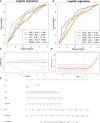Platelet-to-Lymphocyte Ratio as an Independent Factor Was Associated With the Severity of Ankylosing Spondylitis
- PMID: 34804047
- PMCID: PMC8602832
- DOI: 10.3389/fimmu.2021.760214
Platelet-to-Lymphocyte Ratio as an Independent Factor Was Associated With the Severity of Ankylosing Spondylitis
Abstract
The study was aimed to determine the association of the platelet-lymphocyte ratio (PLR) with the disease activity of ankylosing spondylitis (AS). A total of 275 patients, including 180 AS patients and 95 non-AS patients, participated in the study. We assessed a full blood count for each participant. Platelet to monocyte ratio (PMR), monocytes to lymphocyte ratio (MLR), monocyte to neutrophil ratio (MNR), platelet to lymphocyte ratio (PLR), neutrophil to lymphocyte ratio (NLR), and platelet to neutrophil ratio (PNR) were calculated. LASSO and logistic regression analyses were performed to establish the nomogram. Receiver operating characteristic (ROC) analysis was performed to evaluate the clinical value of the nomogram. We constructed a novel nomogram, which incorporated easily accessible clinical characteristics like sex, PLR, WBC, EOS, and ESR for AS diagnosis. The AUC value of this nomogram was 0.806; also, the calibration curves indicated a satisfactory agreement between nomogram prediction and actual probabilities. Furthermore, PLR was positively correlated with the severity of AS. PLR was identified as an independent factor for the diagnosis of AS and was associated with the severity of AS.
Keywords: AS; PLR; diagnosis; nomogram; severity.
Copyright © 2021 Liang, Chen, Xu, Zhang, Xue, Zeng, Jiang, Chen, Qin, Li, Ye, Nie, Zhan and Liu.
Conflict of interest statement
The authors declare that the research was conducted in the absence of any commercial or financial relationships that could be construed as a potential conflict of interest.
Figures






Similar articles
-
Relationship between monocytes to lymphocytes ratio and axial spondyloarthritis.Int Immunopharmacol. 2018 Apr;57:43-46. doi: 10.1016/j.intimp.2018.02.008. Epub 2018 Feb 22. Int Immunopharmacol. 2018. PMID: 29471252
-
Neutrophil/lymphocyte and platelet/lymphocyte ratios as potential markers of disease activity in patients with Ankylosing spondylitis: a case-control study.Adv Rheumatol. 2020 Jan 29;60(1):13. doi: 10.1186/s42358-020-0113-5. Adv Rheumatol. 2020. PMID: 32000859
-
Combination of preoperative neutrophil-lymphocyte ratio, platelet-lymphocyte ratio and monocyte-lymphocyte ratio: a superior prognostic factor of endometrial cancer.BMC Cancer. 2020 May 24;20(1):464. doi: 10.1186/s12885-020-06953-8. BMC Cancer. 2020. PMID: 32448185 Free PMC article.
-
Mean platelet volume, red cell distribution width, platelet-to-lymphocyte and neutrophil-to-lymphocyte ratios in patients with ankylosing spondylitis and their relationships with high-frequency hearing thresholds.Eur Arch Otorhinolaryngol. 2016 Nov;273(11):3663-3672. doi: 10.1007/s00405-016-3980-y. Epub 2016 Mar 31. Eur Arch Otorhinolaryngol. 2016. PMID: 27034281 Clinical Trial.
-
Monocyte-to-Lymphocyte Ratio Was an Independent Factor of the Severity of Spinal Tuberculosis.Oxid Med Cell Longev. 2022 May 20;2022:7340330. doi: 10.1155/2022/7340330. eCollection 2022. Oxid Med Cell Longev. 2022. PMID: 35633888 Free PMC article.
Cited by
-
The Platelet-to-Lymphocyte Ratio Predicts Diabetic Retinopathy in Type 2 Diabetes Mellitus.Diabetes Metab Syndr Obes. 2022 Nov 22;15:3617-3626. doi: 10.2147/DMSO.S378284. eCollection 2022. Diabetes Metab Syndr Obes. 2022. PMID: 36444389 Free PMC article.
-
Monitoring disease activity and treatment response in ankylosing spondylitis: a retrospective study of hematologic inflammatory markers.Rheumatol Int. 2024 Dec 28;45(1):10. doi: 10.1007/s00296-024-05763-6. Rheumatol Int. 2024. PMID: 39733134
-
Development and validation of a machine learning-based nomogram for predicting HLA-B27 expression.BMC Immunol. 2023 Sep 26;24(1):32. doi: 10.1186/s12865-023-00566-z. BMC Immunol. 2023. PMID: 37752439 Free PMC article.
-
Neutrophil-to-lymphocyte ratio and platelet-to-lymphocyte ratio as biomarkers to prognosticate survival in advanced gastric cancer patients in the era of immunotherapy: a systematic review and meta-analysis.J Gastrointest Oncol. 2024 Feb 29;15(1):33-51. doi: 10.21037/jgo-23-808. Epub 2024 Jan 17. J Gastrointest Oncol. 2024. PMID: 38482212 Free PMC article.
-
Construction of a predictive model for blood transfusion in patients undergoing total hip arthroplasty and identification of clinical heterogeneity.Sci Rep. 2024 Jan 6;14(1):724. doi: 10.1038/s41598-024-51240-2. Sci Rep. 2024. PMID: 38184749 Free PMC article.
References
Publication types
MeSH terms
Substances
LinkOut - more resources
Full Text Sources
Medical
Research Materials
Miscellaneous

